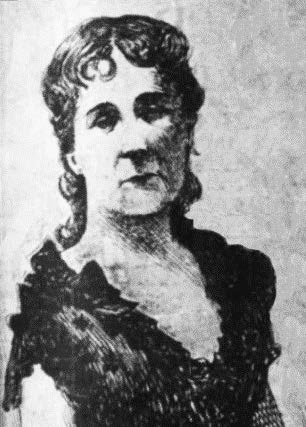The information below has been compiled from a variety of sources. If the reader has access to information that can be documented and that will correct or add to this woman’s biographical information, please contact the Nevada Women’s History Project.

Courtesy The Honolulu Advertiser, 1901.
ANNA MARISKA SHULTZ FITCH (1840 – 1904)
At a Glance:
Born: March 1840, Shoreham, Vermont
Died: April 15, 1904, Los Angeles, Calif.
Maiden Name: Anna Mariska Shultz
Race/nationality/ethnic background: Caucasian
Married: Thomas Fitch, 1863
Primary city and county of residence and work: Washoe City, Virginia City, Nevada; Honolulu, Hawaii; Los Angeles, California
Major fields of work: Author, Anti-suffrage
Other role identities: Congressional wife
First published Nevada author was well-traveled woman
When one thinks of most women in the mid to late 19th century, mental pictures of a woman in a long dress whose interests center predominately around home and family generally come to mind. But this was an era of active women’s suffrage and women began entering traditionally male-dominated fields. Some of those women were more active than others; Anna Shultz Fitch fits that category.
The Hawaii Honolulu Advertiser obituary described the death of Anna as, “removes a woman who had achieved fame in the West as an author and one who figured no less prominently in the early days of Nevada and California than did Col. Fitch, her husband.” The April 16, 1904, edition of the Los Angeles Times said that “… she was an authoress of note and a woman who numbered many brilliant characters among her personal acquaintances.”
How did she acquire such literary stature? Anna’s most important influence was her husband, Thomas Fitch. Fitch was a wanderer searching for his life’s goal; that of a U.S. Senator or Territorial Governor, a pinnacle of political success which he never seemed to find. He was fortunate in his searching that he met a young San Francisco author, Anna Mariska Shultz, and he married her there on January 1, 1863.
At this point her geographical world expanded far beyond her wildest imagination. She moved with Tom to all the Western territories (including Hawaii) and numerous states well over 20 times as he sought that elusive U.S. Senator position or governorship of a territory. Even though he attained the high rank of a U.S. Congressman from Nevada, that wasn’t enough. An orator with a keen mind, he seemed to have no equal, and he became known far and wide as the “Silver Tongued Fitch.”
However, by the prestige Anna achieved in the literary field, it seems to prove that he met his match intellectually. Anna achieved her success as she relentlessly moved from one home to another, for Tom felt it was necessary to purchase a home and establish residency in every move to show that he was serious about being a permanent resident. Setting up one household, or even several, could be considered average for a married couple. Setting up the number of households she had to and still making time for writing, as well as anti-suffrage activities and other social involvements, would be considered superhuman, even by today’s standards.
Anna was born in Shoreham, Vermont in 1840. It’s not known when she moved to San Francisco. Almost immediately after her 1863 marriage, her extensive traveling began. In the February 26, 1881, issue of the Reno Evening Gazette: “At the Metropolitan hotel are Mr. and Mrs. Fitch, who have probably lived in more of the United States than any of its known citizens; that is to say, they have lived in professional and social importance in more of the Territories than any couple I know.”
Coming to Nevada in 1863 and living in both Virginia City and Washoe City, Tom, a newspaper owner, and editor, also was admitted to the Nevada Bar in 1864. He became Washoe County Attorney, practiced law, and ran a newspaper. Anna associated with Mark Twain, Dan De Quille, R.M. Daggett, and Joseph T Goodwin because of Tom’s business relationships. She was at ease in those social settings and, although she was known in the San Francisco area for her writings before marriage, she undoubtedly learned some literary techniques from those men to gain the literary reputation she held nationwide. She even collaborated with some of them in a newspaper series.
Anna became active in the Nevada anti-suffrage movement and wrote a lengthy “Open Letter to Hon. Curtis J. Hillyer” that was published in the Territorial Enterprise on April 25, 1869. Her use of the English language against Assemblyman Hillyer’s legislation supporting a women’s right to vote was masterful. However, her powerful argument didn’t reverse his support of suffrage and the amendment to the Nevada Constitution he introduced, requesting that the word “male” be struck from Article II, the Suffrage clause, passed. Suffragists were jubilant and had high expectations for successful passage in the 1871 Legislature when it would be voted on a second time. In that session Anna’s anti-suffrage arguments held sway, and the bill failed to pass. That 1869 session was the earliest formal attempt at women’s suffrage in Nevada. It wasn’t until 1911 that serious attempts were made again, and Nevada women finally gained the right to vote in 1914.
As an author, Anna is notable for an exceptional accomplishment. In 1870 she published her first of three books, “Bound Down, or Life and its Possibilities.” By that early date, until additional documentation is found to the contrary, she is credited with being the first woman to have a book published in Nevada or any of the Western territories or states. (Sarah Winnemucca Hopkins’ “Life Among the Piutes: Their Wrongs and Claims” was published in 1883, 13 years later.) Anna also published many of her numerous poems. She was held in high stature in the literary world.
Anna continued writing and published two more books. In 1882 “The Loves of Paul Fenley” went to print and 1891 she co-wrote with husband Tom, “Better Days, or a Millionaire of Tomorrow.” This book went into four printing editions.
With all the many moves, Anna’s health became fragile and when she was ailing with Bright’s Disease, now called nephritis, the couple moved to Hawaii in 1891. They returned to Los Angeles in 1903, and Anna died three months later. Both she and Tom are buried in Hayward, California.
Researched and written by Patti Bernard
Posted July 20, 2022
Sources of Information
- “Death of Mrs. Thomas Fitch at Los Angeles.” The Honolulu Advertiser (Honolulu, Hawaii). 16 April 1904, p. 3.
- Fitch, Anna M. “Open Letter to Hon. Curtis J. Hillyer.” Territorial Enterprise (Virginia City, Nevada), 25 April 1869, p. 1.
- Fitch, Thomas and Anna. “Better Days, or A Millionaire of Tomorrow.” The Silver State (Unionville, Nevada), 14 December 1891, image 2. The Silver State [Unionville, Nev.), 14 Dec. 1891. Chronicling America: Historic American Newspapers. Lib. Of Congress. https://chroniclingamerica.loc.gov/lccn/sn84022060/1891-12-14/ed-1/seq-2
- “Married In San Francisco, Jan 1st, Thomas Fitch to Anna M. Shultz”. Sacramento Daily Union (Sacramento, California), 5 Jan 1863, Volume 24, Number 378.
- “Mrs. Fitch’s New Novel.” Carson Daily Appeal (Carson City, Nevada), 15 June 1870, p. 2.
- “Mrs. Thomas Fitch.” The Honolulu Advertiser (Honolulu, Hawaii), 6 June 1901, p. 3.
- “New Book.” Gold Hill Daily News (Gold Hill, Nevada), 15 June 1870.
- “The New York Tribune has the following account of Tom Fitch….” Reno Evening Gazette (Reno, Nevada), 26 February 1881, p. 3.
- “This morning at 4:30 o’clock Mrs. Thomas Fitch, wife of Thomas Fitch died…” The San Bernardino County Sun (San Bernardino, California), 16 April 1904, p. 9.
- NWHP Biography Anna Mariska Shultz Fitch Page 4 of 4
- “Tom Fitch’s Book.” Reno Evening Gazette (Reno, Nevada), 23 November 1891, p. 3.
- “Tom Fitch Is Here-Most Famous of Job Chasers Arrives.” The Honolulu Advertiser (Honolulu, Hawaii), 25 April 1901, p. 14.
- “Woman Author Dies here.” The Los Angeles Times (Los Angeles, California), 16 April 1904, p. 1.

